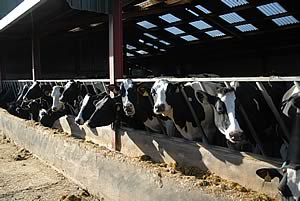 |
|||||||||
|
|||||||||||||||||||
|
|
New
Dairy Herd Study Reveals PLI is Worth £4.50
per Point A new independent study measuring the financial performance of dairy herds has revealed stark differences between low and high genetic merit herds.
The difference in margin between a herd of average genetic merit (Profitable Lifetime Index 14), and a herd in the top 1% (PLI 75) has been shown to be, on average, £286 per cow per year, equating to a staggering £28,600 annually for a 100 cow herd. In other words, one point of PLI is worth over £4.50/cow/year. The study has used completely independent genetic data from DairyCo breeding+ and fully bank-reconciled figures from herds using Promar Farm Business Accounts service. It involved over 20,000 Holstein cows in herds averaging around 7,500 litres, and is the first study of its kind to be undertaken for over 10 years. “In arriving at a margin, we have considered all identifiable income and costs which are likely to vary in herds of different genetic merit,” says Tim Harper from Promar, who undertook the study. “This includes milk, calf and cull sales and the costs of all feed, herd replacements, vet and med, AI and semen. “Assuming there is no relationship between genetics and any other costs, the margin will translate directly through to pre-tax profit.” Commenting on the findings, DairyCo breeding+ director, Marco Winters says: “Of course it’s no surprise to us that the highest genetic merit cows are the most profitable. After all, this is precisely what genetic indexes in general and PLI in particular have been designed to identify. “But it is important to check what is happening in practice from time to time, and the results of this study are extremely reassuring. We expected several of the costs to be higher for the high PLI animals, including those for feed, herd replacements, veterinary and semen, and this has been shown to be the case. But the extra income generated by the high PLI animals from milk sales per individual cow in the herd is overwhelming, and more than compensates for the extra costs of keeping that cow. “Of course, we’re not suggesting that good breeding is the only factor in determining the profitability of these herds,” he adds, “but it clearly has a very important influence. It is equally reassuring to find that its influence has been demonstrated over a cross-section of the herd types which use these Promar costings. “The resounding message is that good quality genetics are helping to keep the most profitable farmers ahead. It’s definitely worth all producers taking note of these results and investing in PLI as part of a package of measures to improve their financial performance. “A further challenge must be to find the right balance in continuing to improve the genetic merit of the national dairy herd while reducing the additional costs of keeping higher genetic merit cows,” he adds. “The new PLI itself will do much to help in this endeavour, with its far greater emphasis on health and fitness traits than was ever the case in the past.” Observing that the study was undertaken using Promar’s Farm Business Accounts for the year ending in 2006, Tim Harper concludes: “Since there have been significant changes to the economics of milk production since that time, these will have an impact on the relationships. We would expect the link between PLI and profitability to be even greater in the current economic climate, further strengthening this important message.”
|
||||||||||||||||||

|
|
||||||||||||||||||
| home | agri-services | pedigree
pen | news | dairy | beef | machinery property | organisations | site map |
|||||||||||||||||||
